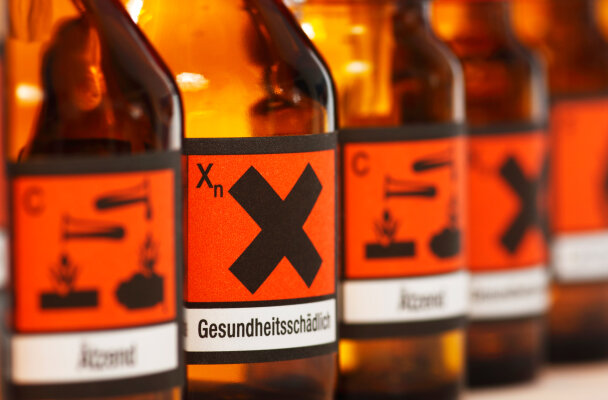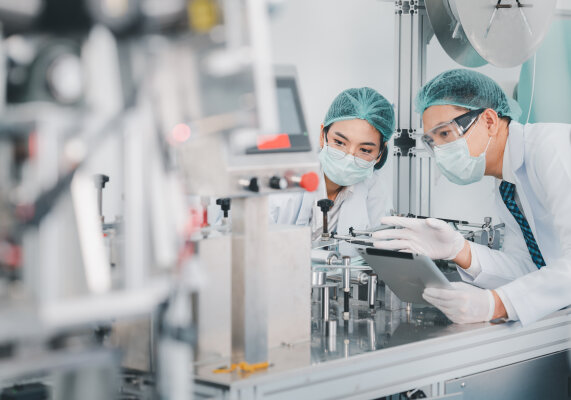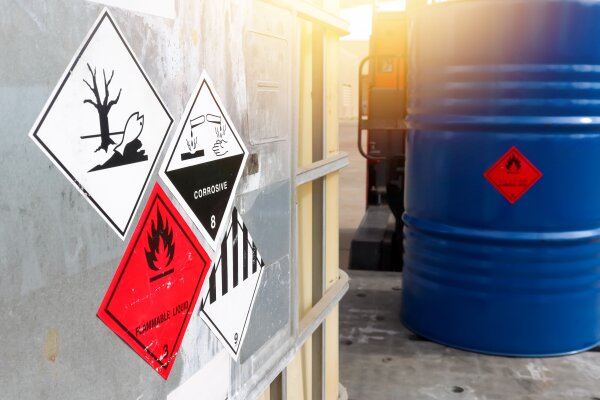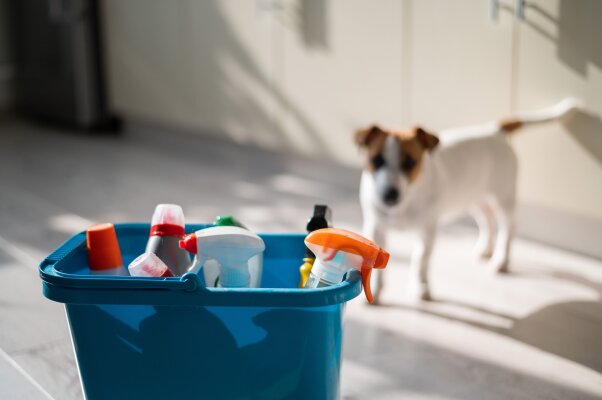Proper autoclaving with the steam sterilization process
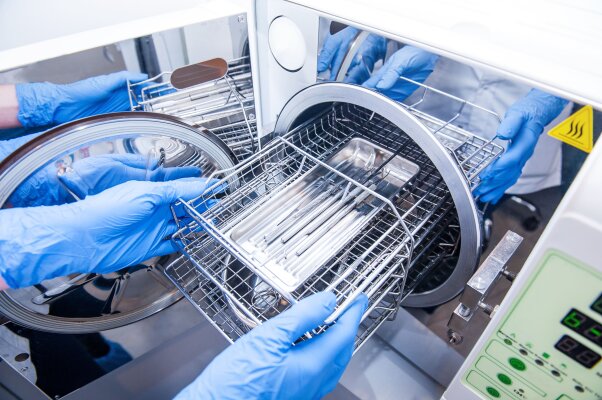
To sterilize liquids, solids and biological hazardous materials, the steam sterilization process is mostly used. For this purpose, an autoclave is used, which must demonstrably produce reproducible results. Read here about the correct operation of an autoclave, which substances may be autoclaved in it and what you need to pay attention to in terms of equipment and legal requirements.
What can be autoclaved?
Autoclaving by steam sterilization is not only one of the most reliable sterilization methods, but is also characterized by a wide range of substances that can be autoclaved.
The device works as follows: Pressure and heat decompose the cells of the unwanted microorganisms. The process is suitable for solids and liquids as well as for biological substances, so that the autoclave is used in the following areas, for example:
- Medicine:medical instruments, surgical linen, swabs
- Biology: preparation of histological sections, culture media
- Food and animal industry: menu dishes, soups, stews
Structure of the autoclave
In principle, the design of an autoclave can be compared to that of a pressure cooker: The autoclave is a pressurevessel that can be sealed gas-tightand is equipped with a lid that can be sealed air-tight. Usually, the autoclave has a cylindrical shape for stability reasons.
A thermometer and a pressure gaugeserve as indicating instruments that monitor the pressurization and the temperature inside the unit. The pressure is built up quite simply by generating steam in the autoclave or by introducing steam. Depending on the requirements, different sizes come into question, which can range from a few liters to several hundred liters.
How to autoclave: Functionality and process for solids
If solids are to be autoclaved, the main distinction to be made is between solids with hollow bodies and those without corresponding cavities. While a simple flow or gravity method can be used for solids without voids, if voids are present, the excess air must first be removed. This is done with the aid of a fractionated prevacuum.
The actual operating time for sterilization of solids also depends on the process and may differ. If venting is required first, the time period is extended accordingly. For solids, autoclaving works in three basic steps:
- Venting phase:Vent the sterilization chamber completely after thoroughly cleaning the load and filling it into the chamber. Use the proven fractionated prevacuum if objects with hollow bodies are involved (think of pipette tips or empty glassware, for example).
- Sterilization phase: This is followed by the sterilization phase, in which the goods are sterilized at 121°C for 20 minutes or at 134°C for 5 minutes. Of course, you should adjust the setting to the sterilization load, for which other time and temperature combinations are also possible.
- Drying phase:At the end, drying is carried out. For this purpose, the steam in the chamber is extracted and the pressure is increased to at least 120 bar, creating a drying vacuum.
How to autoclave: Function and procedure for liquids
If, on the other hand, liquidsare to be autoclaved, the work steps differ somewhat from those for solids. Such sterilization becomes necessary, for example, when liquid substances are involved that must be heated above 100 °C to reach the boiling point. Use the following steps as a guide for this variant:
Heating phase and equalization time
First, the specified temperature must be reached in the liquid. This is called the heating phase. Here it is elementary to pay attention to the size and level of the device – otherwise there is a risk of events such as boiling over, boiling delay or even bursting of the container.
Some autoclaves are now equipped with temperature measurement in a reference device to facilitate this step. The elapsed time until the point where the temperature in the pressure vessel of the device equals that of the liquid is called the equilibration time. Once this balance has been reached, the sterilization phase can be started.
Sterilization phase
This is followed by the actual sterilization of the liquid, which must comply with the regulations of DIN EN 61010-2-040. The sterilization phase begins when the desired temperature is reached in the pressure vessel of the device and lasts until the previously set time period has elapsed. The compensation time does not yet count as sterilization time!
Cooling phase
Once the liquid has been autoclaved, the cooling phase follows. This extends to a safe removal temperature of the sterilized goods. Two cooling systems can be distinguished here:
- Evaporation: In the more frequently implemented evaporation, the liquid is boiled in the cooling phase. Either self-cooling is achieved by a slow steam release, by a fan or by water cooling without support pressure. However, cooking entails a loss of liquid, and the risk of overcooking also increases. Therefore, this cooling is only recommended for open vessels.
- Radiation: This is contrasted with cooling by radiation, in which heat is radiated from the liquid. For this purpose, a supporting pressure is generated by external cooling coils, which is why boiling of the liquid is not necessary. This cooling has fewer disadvantages and allows a significant gain in productivity, but is in doubt more expensive to purchase.
How to autoclave: Mode of operation and process for biological substances
Third in the group are biological substances, which can also be autoclaved. Since GMOs (genetically modified organisms) must be inactivated prior to disposal, legislation requires exclusive autoclaving of these goods. The same applies to contaminated laboratory waste, even if it has not been genetically modified.
If biological materials are to be autoclaved, the device must have suitable technical equipment. It is not uncommon for these to be ordered separately when placing the order. As a rule, filtration is included, which retains microorganisms.
What must not be autoclaved?
However, there are also some items and liquids that must not be autoclaved under any circumstances. The reasons for this can vary and range from simple resistance to sterilization to a hazard to the operator or the autoclave. Things that must not be autoclaved include the following in particular:
- Chemicals with hazardous properties: If chemicals are flammable, explosive, corrosive or toxic, for example, they must be disposed of by trained safety personnel. Autoclaving is not an option, which also applies to bleach or nitrocellulose, for example.
- Sharp objects:If syringes, needles, pieces of glass or scalpels are to be disposed of, no prior sterilization is required. Instead, sharps are disposed of separately.
- Biotoxins:Biotoxins such as prions are simply resistant to sterilization, so the autoclaving process would not be effective.
- Animal or human cellulose:These fall under the category of pathological waste and simply cannot be sterilized with an autoclave. Instead, they are usually burned.
Sterilization by autoclaving: Instruction
To ensure an optimal sterilization process, you should pay attention to some important stepswhen operating the autoclave. We have summarized these for you below as a guide.
Testing the device
First make sure that the autoclaving unit isready for operation. For example, there must be no damage. Any loose material must be wrapped or packed, and all containers must be open, otherwise you risk creating hollow bodies and bursting during autoclaving. Use only heat-resistant plastics in the unit and provide all items with autoclave tape.
Loading the steam sterilizer
Once the testing of the device is complete, the actual loading of the sterilization material follows. Here, too,closed containers and air-filled spaces must be avoided. Wear suitable protective clothing (including eye protection and closed shoes!) and place the autoclave load at a good distance inside the steam sterilizer. Before operation, check that the lid has been closed properly.
Program selection: Setting the correct autoclave temperature
Then select the appropriate program for yourautoclaving cycle. In the meantime, two programs have become established for most devices:
Temperature for autoclave:121°C at 20 minutes and 2.1 bar absolute pressure
Temperature for autoclave: 121°C at 20 minutes and 2.1 bar absolute pressure
In addition, there are also some test programs that serve the maintenance of the autoclave device. This can be used, for example, to determine whether the sterilizer is tight and is venting properly. In particular, the following two test programs should be run regularly:
Vacuum test program:at least once a week to check the tightness of the device
Bowie-Dick test program:daily before start of operation as air removal and vapor penetration test
Unloading
After sterilization, you can already unload the autoclave. Do not open the unit until the autoclaving cycle is complete and both the pressure and temperature have dropped to a safe level. Open the lid a crack and let the remaining steam escape.
Special case: Acting in the event of malfunctions or accidents
As with other technical equipment, malfunctions and accidents can also occur with an autoclaving unit. Always record these in a log book and under no circumstances attempt to repair the device yourself – there is a risk of injury. Report all incidents to your supervisor and remove any spilled fluid before using the equipment again.
Qualification and validation
In order for an autoclave to be allowed to be put into operation at all and for its performance and the reproducibility of the results to be ensured, qualification at the start of operation and regular validation are required. This is required by law – see our blog on autoclave validation for more information.
Outline of the processes
The qualification of the autoclaving device is performed at the start of operation and indicates whether the device is suitable for the intended use. Among other things, this involves checking whether the sterilization process leads to a reproducible result. Above all, the following three qualification steps are necessary for this:
- Installation Qualification (IQ): Verification of the device characteristics with regard to the planned specifications and their implementation as well as installation.
- Functional Qualification (OQ): testing the functionality of the device with respect to the planned and implemented specifications.
- Performance Qualification (PQ):Verification of the feasibility of the planned services with respect to the equipment specifications.
Validation process
Validation of the autoclave is a procedure that must be performed at regular intervals. This ensures that functionality does not diminish and that optimum sterilization results continue to be achieved. After a commissioning, there is a performance assessment, which must be carried out by a specialized company.
Required equipment and legal requirements
Since the sterilization process is a legally regulated process, you must pay attention to some importantfactors and specifications, both in the equipment of the device and in its operation. These are especially important:
- Validation:DIN EN 13485 stipulates that validation must take place in accordance with a documented procedure. Pay attention to the correct intervals here.
- Protective equipment:Added to this is the need for PPE (personal protective equipment), which is even supported at the European level.
- Condensate activation and exhaust air filtration:§22 in the GenTSV (Genetic Engineering Safety Ordinance) states that both condensate activation and exhaust air filtration are required in S2 laboratories (genetic engineering and biosubstances). This is especially true when dealing with sensitizing and toxic substances.
- DIN 58951: DIN 58951 stipulates that any excess air must be removed from cavities before an autoclaving process. A corresponding device is considered a requirement for the autoclaving device so that the fractionated pre-vacuum can be generated.
With the steam sterilizer, your laboratory is quickly autoclaved
In order for solids, liquids and biologicals to be autoclaved properly, it is mandatory to have the right equipment in the autoclaving device as well as the optimal procedure. This is the only way to ensure that sterilization was performed under the appropriate conditions. The steam sterilization process has already proven itself and can also demonstrate in your laboratory why it enjoys such high popularity.
Do you have questions about the topic or would you like to suggest a topic? Please feel free to contact us by phone at +49 30 2096579 00 or send us an email to info@medsolut.com.

